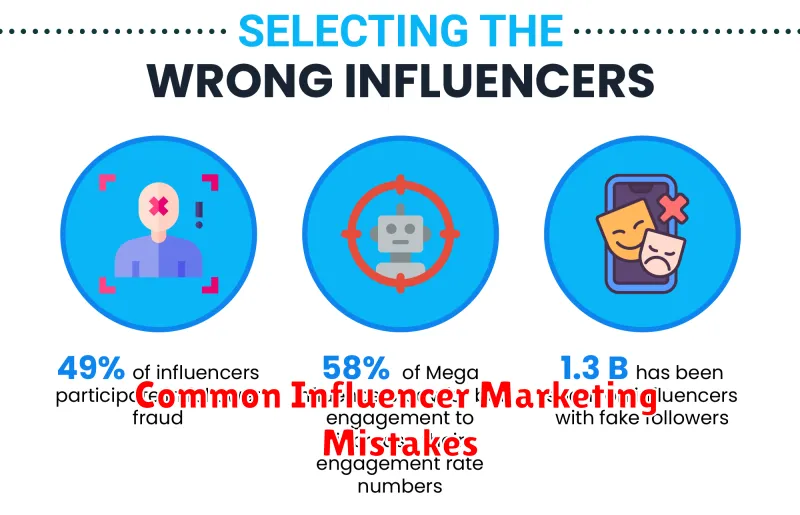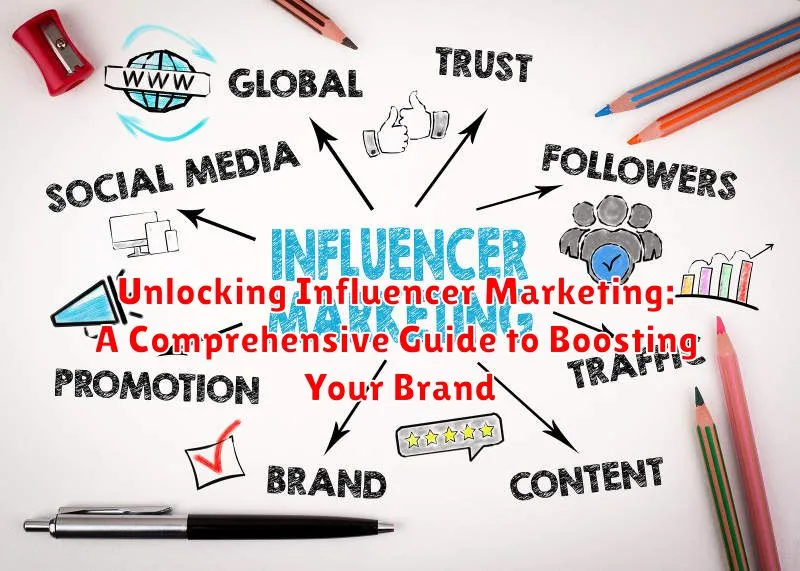In today’s digital landscape, influencer marketing has become an indispensable strategy for brands seeking to expand their reach and engage with target audiences effectively. This comprehensive guide delves into the intricacies of influencer marketing, providing valuable insights and actionable strategies to boost your brand’s visibility, drive engagement, and ultimately achieve significant growth. Whether you are a seasoned marketer or new to the concept, this guide will equip you with the knowledge and tools to unlock the full potential of influencer marketing and elevate your brand to new heights. We’ll explore the core principles of identifying the right influencers, crafting compelling campaigns, measuring ROI, and navigating the evolving landscape of this dynamic marketing channel.
From understanding the various types of influencer marketing campaigns, such as sponsored posts, affiliate marketing, and influencer-generated content, to mastering the art of negotiation and contract development, this guide will provide a comprehensive overview. Learn how to leverage data-driven insights to identify key performance indicators (KPIs) and optimize your influencer marketing strategies. Discover best practices for building authentic partnerships with influencers that resonate with your target audience and generate tangible results. This guide serves as your roadmap to navigating the complexities of influencer marketing and harnessing its power to achieve your marketing objectives and drive business success.
What is Influencer Marketing?
Influencer marketing is a strategic marketing approach that leverages the reach and credibility of influencers to promote brands, products, or services. Influencers are individuals who have established a significant following and authority within a specific niche or industry. They possess the power to impact their audience’s purchasing decisions and shape consumer behavior.
Essentially, influencer marketing involves collaborating with these individuals to create authentic content that resonates with their followers. This content can take various forms, including sponsored posts, product reviews, social media mentions, and even dedicated blog articles or videos. The goal is to tap into the influencer’s existing audience and build brand awareness, generate leads, and ultimately drive sales.
Influencer marketing differs from traditional celebrity endorsements. While celebrities possess widespread fame, influencers cultivate a deeper connection with their audience based on shared interests, values, and trust. This genuine connection is what makes influencer marketing so effective in reaching target demographics and achieving measurable results.
Why is Influencer Marketing Effective?
Influencer marketing leverages the trust and credibility that influencers have built with their audience. This established connection allows brands to tap into a pre-engaged community and bypass the hurdles of traditional advertising, which is often perceived as intrusive or impersonal.
Recommendations from a trusted source hold significant weight. Influencers act as authentic advocates, creating genuine interest and desire for a brand’s products or services among their followers. This organic approach leads to higher engagement and conversion rates compared to generic marketing efforts.
Furthermore, influencer marketing allows for targeted reach. By partnering with influencers who align with their target demographic, brands can ensure their message is delivered directly to the right consumers. This focused approach maximizes impact and minimizes wasted ad spend.
Types of Influencer Marketing
Influencer marketing campaigns can take various forms, each with its own strengths. Understanding these types is crucial for selecting the right approach for your brand.
Social Media Campaigns
This is the most common type, leveraging influencers’ established presence on platforms like Instagram, TikTok, and YouTube. These campaigns often focus on brand awareness and driving traffic.
Blog Posts and Articles
Long-form content, like blog posts or articles, provides a deeper dive into a product or service. Influencers can offer reviews, tutorials, or comparisons to educate their audience.
Events and Experiences
Influencers can participate in or host events related to your brand, providing real-world engagement with their audience. This can generate buzz and excitement.
Affiliate Marketing
This performance-based approach involves influencers earning a commission for every sale generated through their unique links or codes. It’s highly measurable and focuses on direct sales.
Sponsored Content
Brands can sponsor content created by influencers, ensuring their message reaches a targeted audience. This can include dedicated posts, stories, or videos.
How to Find the Right Influencers
Finding the right influencers is crucial for a successful campaign. It’s not just about follower count; it’s about finding influencers whose audience aligns with your target market and whose content resonates with your brand values.
Start by clearly defining your campaign goals and target audience. What do you want to achieve with this campaign? Who are you trying to reach?
Several tools and platforms can assist in your search. Influencer marketing platforms offer databases of influencers, allowing you to filter by niche, audience demographics, and engagement rates. Social listening tools can help identify influencers who are already talking about your brand or industry. Manual searching through relevant hashtags and exploring social media platforms is also an effective method.
When evaluating potential influencers, consider their audience engagement, content quality, and authenticity. Look for influencers who genuinely connect with their followers and create high-quality content that aligns with your brand’s message.
Measuring Influencer Marketing ROI
Measuring the return on investment (ROI) of your influencer marketing campaigns is crucial to understanding their effectiveness and optimizing future strategies. While not always straightforward, several key metrics can help you quantify your success.
Key Performance Indicators (KPIs) for influencer marketing often depend on campaign goals. For brand awareness campaigns, track metrics like reach, impressions, and social media engagement (likes, comments, shares). Sales-driven campaigns should focus on conversions, using trackable links, promo codes, and affiliate marketing platforms to measure direct sales attributed to influencers.
Calculating ROI involves comparing the value generated by the campaign against the cost of the campaign. Value can be measured in terms of revenue generated, customer lifetime value (CLTV) increase, or equivalent media value. Cost includes influencer fees, content creation expenses, and platform or agency fees.
Use a simple formula like (Value – Cost) / Cost x 100% to determine your ROI percentage. A positive ROI indicates a profitable campaign, while a negative ROI suggests areas for improvement.
Beyond quantitative data, also consider the qualitative impact of your influencer marketing efforts. This includes factors like brand sentiment, audience feedback, and the quality of user-generated content created around your brand.
Building a Successful Influencer Marketing Campaign
A well-structured campaign is crucial for influencer marketing success. Begin by defining clear objectives. Are you aiming for increased brand awareness, higher sales, or more website traffic? A specific goal will guide your strategy.
Next, identify your target audience. Understanding your ideal customer will help you select the right influencers who can reach them effectively. Consider demographics, interests, and online behavior.
Develop a compelling campaign message that resonates with your audience and aligns with the influencer’s style. Provide influencers with creative freedom while ensuring brand consistency.
Establish a realistic budget and timeline. Outline the scope of the campaign, including deliverables, payment terms, and content scheduling. Clear communication is key to a smooth collaboration.
Finally, track and measure your campaign’s performance. Analyze key metrics like engagement, reach, and conversions to assess the effectiveness of your strategy and make adjustments as needed.
Common Influencer Marketing Mistakes

Even with careful planning, influencer marketing campaigns can fall short if certain common pitfalls aren’t avoided. One frequent mistake is choosing influencers based solely on follower count. Large numbers don’t guarantee engagement or alignment with your target audience.
Ignoring audience demographics is another critical error. An influencer’s audience must align with your ideal customer profile for the campaign to be effective. Similarly, lack of clear campaign goals can lead to wasted resources and poor results. Define specific, measurable, achievable, relevant, and time-bound (SMART) objectives from the outset.
Failing to disclose sponsored content properly can damage brand credibility and violate advertising regulations. Transparency is paramount. Finally, neglecting to measure campaign performance prevents you from understanding what works and optimizing future efforts. Track key metrics to demonstrate ROI and refine your strategies.
Best Practices for Influencer Marketing

To maximize the impact of your influencer marketing campaigns, consider these best practices:
Set Clear Goals and KPIs
Define your objectives from the outset. Are you aiming for increased brand awareness, website traffic, or sales? Establish key performance indicators (KPIs) to track progress and measure success.
Prioritize Authentic Partnerships
Choose influencers whose values align with your brand and whose audience resonates with your target market. Authenticity is crucial for building trust and credibility.
Craft Compelling Content
Collaborate with influencers to create high-quality, engaging content that provides value to their audience. Encourage creativity while ensuring the content aligns with your brand messaging.
Disclose Relationships Transparently
Maintain transparency by clearly disclosing sponsored partnerships. This fosters trust with both the influencer’s audience and regulatory bodies.
Analyze and Optimize
Regularly monitor campaign performance and analyze the data. Use these insights to optimize future campaigns and improve your ROI.

